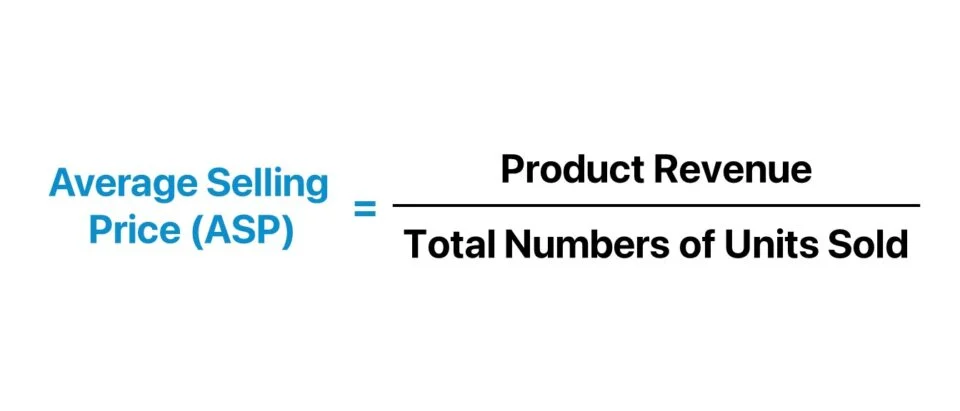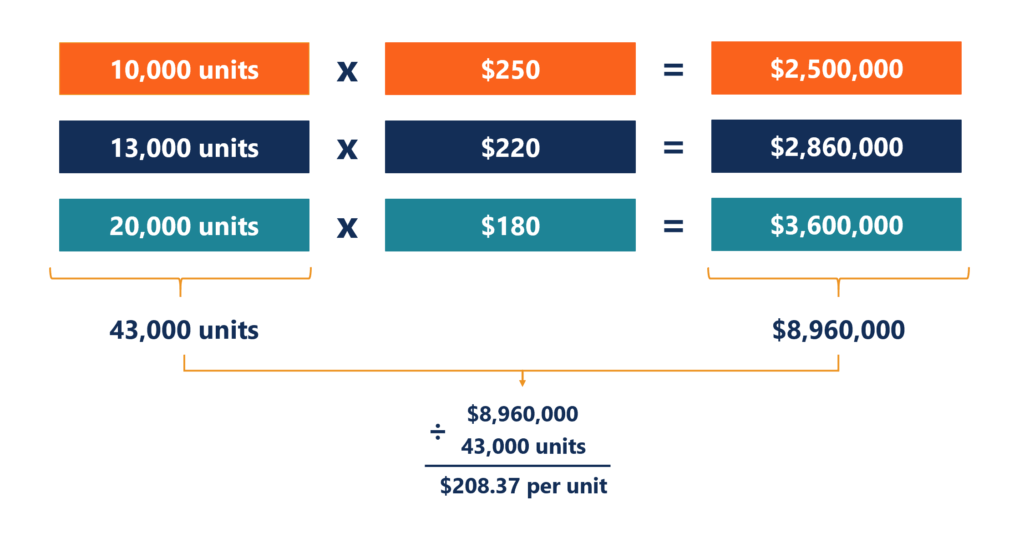The term average selling price (ASP) refers to the price at which a certain class of good or service is typically sold. The average selling price is affected by the type of product and the product life cycle. The ASP is the average selling price of the product across multiple distribution channels, across a product category within a company, or even across the market as a whole.

What is the Average Selling Price (ASP)?
The average selling price (ASP) is a term that refers to the price that a good or service is sold for. As the name implies, it is an average price. If a company sells hundreds of thousands of cell phones each year at different prices, you calculate the ASP by taking the total revenue earned by cell phone sales and divide that amount by the total number of units sold.
The average selling price can be used as a benchmark in a few different ways. Companies entering a new market may look at the ASP of a good or service to position themselves when they bring their product to market.Companies will often report their ASPs during quarterly earnings calls. Analysts and investors will look at the trend of a company’s average selling price and draw conclusions from it. The price of a product will depend on the type of product and where the product is in its product cycle. As a product ages and becomes obsolete, the average selling price often decreases.
Other names for average selling price include “average order value,” which is commonly seen in e-commerce. In the hospitality industry, a similar metric called “average daily rate” shows the average rate customers will pay for one day’s stay at their properties.
How to Calculate Average Selling Price (ASP)
A luxury handbag maker saw a big year in 2020. They sold 10,000 units at $250 each, 13,000 units at $220 each, and 20,000 units at $180 each. Let’s calculate what their average selling price was.
First, let’s calculate the total amount of revenue the company earned.
10,000 * $250 = $2,500,000
13,000 * $220 = $2,860,000
20,000 * $180 = $3,600,000
The total amount of revenue earned by the company was $8,960,000. Next, we add up the number of units sold, which comes out to 43,000. The final step is to divide the total revenue by the number of units sold. The calculation results in an average selling price of $208.37.

Uses of the Average Selling Price
1. Entry strategy- Companies that are entering a new market can use the average selling price to create their strategy on how they want to position themselves. Imagine that a company is looking to begin manufacturing men’s sunglasses.
When they look at the market, they see that the ASP of sunglasses is $65. The business may decide to set their price at $100 to position themselves as a premium retailer. They may set the price at $50 to be a value retailer or come in with a price equal to that of the market. It depends on what the business thinks is the best and most profitable route.Entering at a lower selling price may result in tight profit margins. Entering at a premium price may lead to higher margins, but lower sales numbers.
2. Trends and decision-making-
For companies currently in the market with a specific product or service, they can use the average selling price to identify trends and make decisions. If a company specializes in financial services and sees the average selling price of a certain service dropping over time, it can be a sign that the market for that service is drying up. The demand is declining, and the company must exit the market.
A rising ASP isn’t always a positive thing, and a declining ASP isn’t always a negative thing. For example, a company initially sells video game consoles at $400 per unit and sells 100,000 units in the first year. That is $40,000,000 in revenue. The next year they drop their average selling price to $300 per unit.
A 25% drop may sound frightening, but with the fall in price, the company ended up selling 200,000 in the second year for $60,000,000 in revenue. Revenue increased by 50% even though the selling price decreased. Lowering prices to achieve a larger volume of sales is a tradeoff that businesses are
willing to make. It works in the other direction as well. A rising ASP will eventually reach a point where each increase in price drives down the volume of sales, eventually making it detrimental to raise prices any further.
For Investors and Analysts
1. Draw conclusions- The investment community will analyze the average selling price to try to make conclusions about a product or service, a business, or a market. Take GoPro as an example. GoPro’s business primarily revolves around one device – action cameras.
When a company is mainly built on one product, the investment community will monitor the average selling price of that product. A drop in price can point to rising competition, lower pricing power with their customers, or a decrease in demand, which can lead to failure.
FAQs
Why is the ASP important for businesses?
ASP is important for businesses as it provides insights into pricing trends, helps in setting competitive prices, and serves as a key metric for evaluating the overall revenue performance of a product or service.
What factors can influence changes in ASP?
Changes in production costs, demand fluctuations, competitive pricing strategies, changes in market conditions, and shifts in consumer preferences can influence variations in ASP.
How often should businesses calculate ASP?
The frequency of calculating ASP depends on the industry, market dynamics, and the need for up-to-date pricing information. It is common for businesses to calculate ASP quarterly or annually.
Practice area's of B K Goyal & Co LLP
Income Tax Return Filing | Income Tax Appeal | Income Tax Notice | GST Registration | GST Return Filing | FSSAI Registration | Company Registration | Company Audit | Company Annual Compliance | Income Tax Audit | Nidhi Company Registration| LLP Registration | Accounting in India | NGO Registration | NGO Audit | ESG | BRSR | Private Security Agency | Udyam Registration | Trademark Registration | Copyright Registration | Patent Registration | Import Export Code | Forensic Accounting and Fraud Detection | Section 8 Company | Foreign Company | 80G and 12A Certificate | FCRA Registration |DGGI Cases | Scrutiny Cases | Income Escapement Cases | Search & Seizure | CIT Appeal | ITAT Appeal | Auditors | Internal Audit | Financial Audit | Process Audit | IEC Code | CA Certification | Income Tax Penalty Notice u/s 271(1)(c) | Income Tax Notice u/s 142(1) | Income Tax Notice u/s 144 |Income Tax Notice u/s 148 | Income Tax Demand Notice | Psara License | FCRA Online
Company Registration Services in major cities of India
Company Registration in Jaipur | Company Registration in Delhi | Company Registration in Pune | Company Registration in Hyderabad | Company Registration in Bangalore | Company Registration in Chennai | Company Registration in Kolkata | Company Registration in Mumbai | Company Registration in India | Company Registration in Gurgaon | Company Registration in Noida | Company Registration in lucknow
Complete CA Services
RERA Services
Most read resources
tnreginet |rajssp | jharsewa | picme | pmkisan | webland | bonafide certificate | rent agreement format | tax audit applicability | 7/12 online maharasthra | kerala psc registration | antyodaya saral portal | appointment letter format | 115bac | section 41 of income tax act | GST Search Taxpayer | 194h | section 185 of companies act 2013 | caro 2020 | Challan 280 | itr intimation password | internal audit applicability | preliminiary expenses | mAadhar | e shram card | 194r | ec tamilnadu | 194a of income tax act | 80ddb | aaple sarkar portal | epf activation | scrap business | brsr | section 135 of companies act 2013 | depreciation on computer | section 186 of companies act 2013 | 80ttb | section 115bab | section 115ba | section 148 of income tax act | 80dd | 44ae of Income tax act | west bengal land registration | 194o of income tax act | 270a of income tax act | 80ccc | traces portal | 92e of income tax act | 142(1) of Income Tax Act | 80c of Income Tax Act | Directorate general of GST Intelligence | form 16 | section 164 of companies act | section 194a | section 138 of companies act 2013 | section 133 of companies act 2013